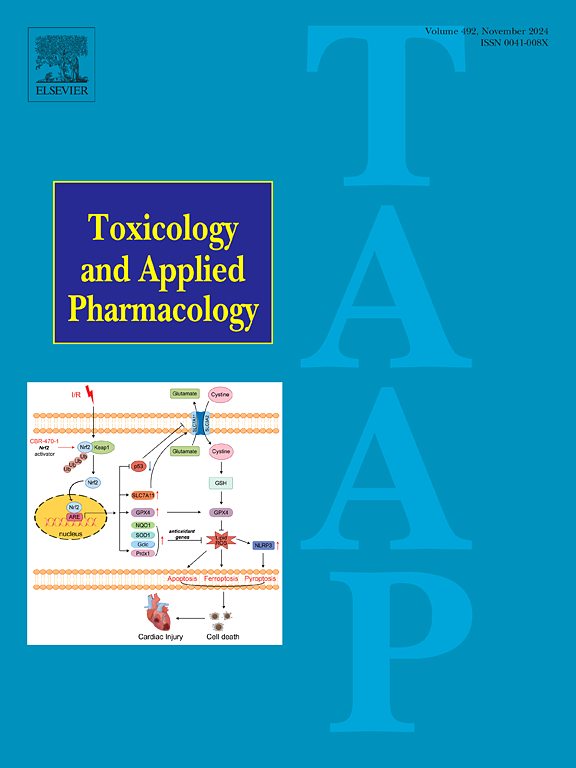Fluvoxamine, an inhibitor of CYP1A2, improves CS-induced pulmonary inflammation through estrogen deficiency
IF 3.4
3区 医学
Q2 PHARMACOLOGY & PHARMACY
引用次数: 0
Abstract
Chronic obstructive pulmonary disease (COPD), one of the most prevalent respiratory diseases worldwide, exhibits marked gender disparities, with women disproportionately affected. Current therapeutic modalities for COPD are relatively ineffective as the available drugs cannot considerably delay disease progression or substantially affect inflammation. Therefore, the suppression of inflammatory responses is considered an essential management strategy for COPD. Fluvoxamine, a CYP1A2 inhibitor with anti-inflammatory effects, and CYP1A2 affects estrogen metabolism. However, its potential as a COPD treatment and interaction with estrogen in women are unclear. This study explored fluvoxamine's efficacy in female mice with cigarette smoke (CS)-induced COPD. Administering 8 mg/kg fluvoxamine intraperitoneally markedly reduced CS-induced lung damage, lowering histopathological injury and pro-inflammatory cytokines in bronchoalveolar lavage fluid and serum. RNA-seq analysis revealed that fluvoxamine significantly suppressed the upregulation of inflammation-related genes. Furthermore, the KEGG and GSEA analysis of differentially expressed genes in lung transcriptomics revealed that the metabolism of xenobiotics by cytochrome P450 and JAK-STAT signaling pathway were regulated after fluvoxamine treatment. WB and ELISA assay also demonstrated a significant decrease in CYP1A2 and estrogen levels following treatment with fluvoxamine or tamoxifen. Crucially, fluvoxamine matched tamoxifen (an estrogen inhibitor) in improving lung structural parameters (mean linear intercept, destructive index). These results suggest fluvoxamine mitigates COPD by inhibiting CYP1A2, reducing inflammatory mediators and estrogen. The proposed mechanism combines estrogen metabolism modulation and anti-inflammatory action, offering dual therapeutic benefits. This study positions fluvoxamine as a novel COPD treatment candidate, particularly for women, targeting hormonal and inflammatory pathways. Further research is needed to validate clinical translation.
氟伏沙明是一种CYP1A2抑制剂,可通过雌激素缺乏改善cs诱导的肺部炎症。
慢性阻塞性肺疾病(COPD)是世界上最普遍的呼吸系统疾病之一,它表现出明显的性别差异,妇女受到的影响尤为严重。目前COPD的治疗方式相对无效,因为现有的药物不能显著延缓疾病进展或实质性影响炎症。因此,抑制炎症反应被认为是COPD的基本管理策略。氟伏沙明,一种具有抗炎作用的CYP1A2抑制剂,CYP1A2影响雌激素代谢。然而,其作为慢性阻塞性肺病治疗的潜力以及与女性雌激素的相互作用尚不清楚。本研究探讨氟伏沙明对香烟烟雾(CS)诱导的雌性COPD小鼠的疗效。8 mg/kg氟伏沙明腹腔注射可显著减轻cs诱导的肺损伤,降低肺组织病理损伤,降低支气管肺泡灌洗液和血清中促炎因子的含量。RNA-seq分析显示,氟伏沙明显著抑制炎症相关基因的上调。此外,肺转录组学差异表达基因的KEGG和GSEA分析显示,氟伏沙明治疗后,细胞色素P450和JAK-STAT信号通路调节了外源药物的代谢。WB和ELISA检测也显示氟伏沙明或他莫昔芬治疗后CYP1A2和雌激素水平显著降低。至关重要的是,氟福沙明在改善肺结构参数(平均线性截距,破坏指数)方面与他莫昔芬(雌激素抑制剂)相匹配。这些结果表明氟伏沙明通过抑制CYP1A2、减少炎症介质和雌激素来减轻COPD。提出的机制结合了雌激素代谢调节和抗炎作用,提供双重治疗益处。这项研究将氟伏沙明定位为一种新的COPD治疗候选药物,特别是针对女性,靶向激素和炎症途径。需要进一步的研究来验证临床翻译。
本文章由计算机程序翻译,如有差异,请以英文原文为准。
求助全文
约1分钟内获得全文
求助全文
来源期刊
CiteScore
6.80
自引率
2.60%
发文量
309
审稿时长
32 days
期刊介绍:
Toxicology and Applied Pharmacology publishes original scientific research of relevance to animals or humans pertaining to the action of chemicals, drugs, or chemically-defined natural products.
Regular articles address mechanistic approaches to physiological, pharmacologic, biochemical, cellular, or molecular understanding of toxicologic/pathologic lesions and to methods used to describe these responses. Safety Science articles address outstanding state-of-the-art preclinical and human translational characterization of drug and chemical safety employing cutting-edge science. Highly significant Regulatory Safety Science articles will also be considered in this category. Papers concerned with alternatives to the use of experimental animals are encouraged.
Short articles report on high impact studies of broad interest to readers of TAAP that would benefit from rapid publication. These articles should contain no more than a combined total of four figures and tables. Authors should include in their cover letter the justification for consideration of their manuscript as a short article.

 求助内容:
求助内容: 应助结果提醒方式:
应助结果提醒方式:


